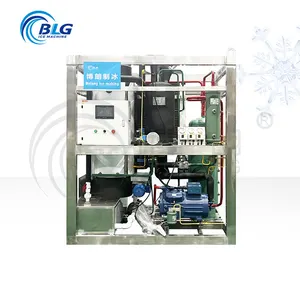(1341 products available)
























































































































































































































































Machines that make ice tubes are helpful for people who sell drinks and need ice on a hot day. These machines come in different sizes, with some making just a little bit of ice and others making a lot in one day. For big businesses, there are machines that can produce a ton of ice every day.
Machines that make ice tubes work by making them directly from water. In the beginning, water is put in a reservoir and then pumped into a freezing cylinder using a pump. Along the cylinder, the water starts to freeze as it gets colder. Once the water is fully frozen, a fan is used to warm up the cylinder, which helps to release the ice tubes. Then a cutter comes in and cuts the ice tubes into smaller pieces, and a conveyor belt takes them to the storage bin where the ice is kept until it's used.
Machines that make ice tubes in large quantities are usually used in industries and other big places where a lot of ice is always needed. Some places where these big machines might be found include hotels, supermarkets, and restaurants. Also, they're really useful at parties and big events.
There are different types of tube ice machines with a production capacity of one ton per day. Ice plant machines can be classified based on how they make ice, their design, size and capacity, efficiency and energy consumption, and technology.
Specifications of tube ice machines vary according to the usage of the machines, their types, and their capacities.
Production Capacity
It presents how much ice the machines can produce in a day or hour. It is usually expressed in tons or pounds. For example, a tube ice machine with a capacity of 3 tons per day can produce approximately 3 tons of ice within 24 hours.
Ice Tube Diameter and Length
Machines typically make ice tubes with diameter and lengths varying from 1 to 3 centimeters and from 3 to 12 centimeters, respectively. The dimensions of ice tubes influence the cooling rate and dilution of beverages.
Water Supply System
There are two ways for the machines to supply water— a direct connection to a water line or a water reservoir.
Cooling System
Tube ice machines can have air or water as refrigerants, such as ammonia, carbon dioxide, or hydrofluorocarbons (HFCs). Refrigerant options affect the efficiency and environmental impact of the ice-making process.
Power Consumption
Tower ice machines’ power consumption is generally between 5 and 20 kilowatts per ton of ice produced, depending on the machine's efficiency and technology. The specific power consumption may vary based on the design and specifications of the ice machine.
Dimensions and Weight
Tube ice machines come in various sizes. The dimension and weight are crucial, as they determine how the machines are installed and used in commercial spaces.
Regular Cleaning
Regular cleaning is important for good ice production and machine durability. It can help maintain hygiene and prevent potential health risks. Tubing ice machines are usually made of plastic or stainless steel, both of which can be cleaned easily.
Descaling
Water contains minerals like calcium and magnesium that can leave deposits known as limescale. Regular descaling is crucial for preventing mineral buildup. Businesses can use descaling solutions or hire professional services to ensure effective and safe descaling.
Sanitization
Sanitization is required to kill bacteria, germs, and viruses. It is an important step after cleaning and ensures that the ice produced is safe and free from contaminants. Using EPA-approved sanitizing solutions can help ensure compliance with safety and health regulations.
Check Water Supply
Maintaining a clean and efficient water supply is essential for optimal ice production and machine performance. Regularly checking the water supply helps ensure that the water source is reliable, and there are no contaminants that could affect ice quality.
The tube ice machine is used to produce tube ice in different industries. Here are some of the applications of tube ice machines:
Food Processing, Preservation, and Storage
In the food industry, tube ice is used for processing, preserving, and storing food products. Tube ice machines are commonly found in fish markets, bakeries, restaurants, and supermarkets. Tube ice helps maintain the freshness of perishable food items such as seafood, poultry, fruits, and vegetables, extending their shelf life. In the food industry's cold chain, tube ice plays a crucial role by keeping food items at low temperatures to prevent spoilage and contamination. This enables efficient transportation and distribution of food products.
Drinks Industries
Tube ice keeps drinks cold and refreshing. It is commonly used in hotels, bars, restaurants, cafes, event venues, and beverage production facilities. The drink industry uses tube ice machines to produce ice for soft drinks, cocktails, beer, and other beverages. Tube ice machines enhance customers' experience in hotels and bars by serving chilled drinks with ice.
Medical and Healthcare
Tube ice is used in the medical and healthcare field for temporary storage of medicines, drugs, and sensitive instruments. Ice machines are commonly found in hospitals, pharmacies, and medical laboratories. Tube ice plays a crucial role in medicine and healthcare by preserving temperature-sensitive medications and ensuring the integrity of medical equipment.
Chemical and Pharmaceutical
In the chemical and pharmaceutical industry, tube ice is used for cooling applications during chemical reactions, maintaining low temperatures, and providing temporary storage for reagents and solvents. Ice machines can be found in chemical manufacturing facilities, pharmaceutical laboratories, and research institutions. Tube ice is essential for controlling reactions and ensuring product quality in the chemical and pharmaceutical industries.
Entertainment and Hospitality
Tube ice machines are popular in the entertainment and hospitality sectors, including cinemas, theme parks, water parks, nightclubs, and event organizing companies. These industries use tube ice for various purposes such as preparing frozen drinks and cocktails, creating ice sculptures and attractions, providing ice to cool drinks counters and stands, and offering customers refreshing beverages.
Buying the right tube ice machine for commercial use within the ton per day requirement can significantly impact business profitability and operational efficiency. Here are some factors that business buyers should consider when choosing industrial tube ice machines:
Daily ice production needs:
Buyers should calculate the amount of ice the business needs on a daily or hourly basis. Consider current usage and future growth to determine if a machine with large or small ice-making capacity is ideal for the business.
Space requirements:
Determine the amount of floor space and storage capacity the business has to accommodate an ice machine and storage bin. Ensure that the machine will fit in the intended location and be able to vent properly.
Water supply requirements:
Consider whether the business has a constant and reliable water supply. Industrial tube ice machines need clean water to make ice. Buyers may need to invest in a filtration system if the local water supply is not suitable.
Energy efficiency and operating costs:
Look for machines with high energy efficiency to minimize electricity costs. Consider the estimated ice production cost based on water and electricity needs to determine operating expenses.
Ease of use and automated features:
Consider how often staff will make ice and what other tasks they need to complete. Look for machines with automatic ice production, bin full indicators, and touch control panels for user-friendly operation.
Cooling options and installation requirements:
Decide between a remote or self-contained cooling system based on installation needs and space constraints. Remote cooling units are distinguished by their quieter operation and smaller footprints.
Inline tube ice machine detachable cylinders:
When considering modular machines, think about how the component parts function together. For instance, in some designs, ice tubes are ejected directly into the storage bin, which is another thing that users need to keep in mind for easier everyday use.
Long-term costs:
Consider the long-term costs of the tube ice maker including energy, water, repair, and replacement parts to determine the total owning cost over time.
Warranty and support:
Consider the warranty period, coverage, and support network of the seller. A strong warranty and accessible technical support can give buyers peace of mind and protect their investment.
Q1: How does a tube ice machine work?
A1: Ice-making happens in a closed loop. Ice is made in evaporators by injecting water. Refrigerant flows through refrigerant coils inside the evaporator, cooling the water and forming ice. Once ice reaches the desired thickness, a warm brine solution or hot gas circulates the evaporator, thawing the ice. An ice screw or conveyor transports ice to a freezing chamber, where a vertical cutter or saw slices ice into tubes. Finally, water flushes out the tubes and collects in a bin.
Q2: How should users maintain tube ice machines?
A2: Regular ice machine cleaning can help businesses provide fresh ice to customers. It also removes any mineral buildup within the machine. Businesses can also hire professional technicians to examine the machine and fix any issues so that it runs smoothly for a long time.
Q3: What kind of water do tube ice machines need?
A3: The machine can use tap water or well water, provided it meets the required analysis before use. However, bottled water is the best option because manufacturers have excellent control over the water source and treatment. As a result, customers will get great-quality ice.